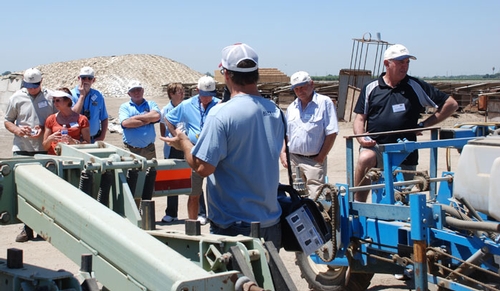Aussie no-tillers visit Valley farmers
Leading San Joaquin Valley conservation tillage farmers Scott Schmidt of Five Points and Dino Giacomazzi of Hanford recently hosted a group of 38 no-till farmers from Western and South Australia. The visit was part of a five-week excursion the Australians were conducting through conservation agriculture regions of the US and Canada.
The Valley tour was jointly coordinated by California’s Conservation Tillage Workgroup, a diverse group of over 1,500 farmer, private sector, public agency and University members, and Crabtree Ag Consulting’s “No-till” Bill Crabtree of Beckenham, Western Australia. Crabtree, a renowned and award-winning no-till pioneer and promoter whose efforts have contributed substantially to the adoption of no-till farming on over 90 percent of the wheat acreage in Western Australia, and California CT workgroup chair Jeff Mitchell of UC Davis met in 2006 at an international conference on no-till adoption in New South Wales, Australia. Crabtree made a presentation at one of the California workgroup’s farmer meetings in 2007 in Five Points. The two no-till researchers have remained in contact since 2006 and worked together in organizing this summer’s conservation farming SJV visits.
This year’s Australian tour group made a stop in the San Joaquin Valley to learn about the progress farmers and researchers have recently made with conservation tillage cropping systems. The group was on their way from visits in Southern California to more traditional no-till regions in the Dakotas and Canada.
Their first farm visit was with Scott Schmidt, manager of Farming ‘D’ in Five Points. The diverse crop mix produced by this farm - which includes processing and fresh market tomatoes, wheat, cotton, onions, garlic, alfalfa and lettuce - contrasted sharply with the monoculture wheat fields common throughout Western and South Australia where average annual rainfall ranges from 200 to 400 mm (8 to 16 inches) and occurs primarily during the winter (similar to the SJV).
Within the diverse crop rotations that are pursued at Farming ‘D,’ Schmidt has developed a number of minimum tillage techniques and implements. He now contemplates converting segments of these rotations to even more ambitious conservation tillage management in the future. Schmidt is also a local pioneer in the use of overhead, mechanized center pivot irrigation.
The flexibility afforded by irrigating with center pivots makes the conversion to more advanced CT systems more feasible. The tillage typically required to establish beds and furrows for surface irrigation may no longer be needed under center pivot irrigation.
Following their visit with Schmidt, the Aussie no-tillers crossed the Valley and were hosted by Dino Giacomazzi and three generations of his family at their dairy in Hanford. Over the past five years, Giacomazzi has developed and refined strip-tillage corn and no-till winter wheat and triticale planting techniques. He proudly and methodically walked his visitors through his entire silage production process.
While the production contexts and details vary widely between Western and South Australia and the San Joaquin Valley, in many ways the fundamental drive toward developing conservation tillage systems that farmers in both regions exemplify are universal. Cutting production costs by reducing tillage passes results first in cheaper production and, as long as yields can be maintained or improved, more profitable production systems.
“What we do as farmers must, in the first place, be economical,” SJV CT farmer Giacomazzi pointed out. “The environmental benefits are great, but our production systems have to be first and foremost economical.”
For Giacomazzi, those environmental benefits have included fewer emissions into the air, more residue on the soil surface, and more organic matter in the soil. For the Australian no-tillers, it has meant combatting soil erosion which was causing lower yields and higher production costs. It had become nothing short of a national plague 20 ago in Western Australia’s light textured soils that are very susceptible to wind erosion.
More information on local conservation tillage is available at the CT Workgroup’s website: http://groups.ucanr.org/ucct/ and in the book by No-till Bill Crabtree, Search for Sustainability with No-till Bill in dryland agriculture.

Giacomazzi (with back to camera) speaks to Australian visitors.

